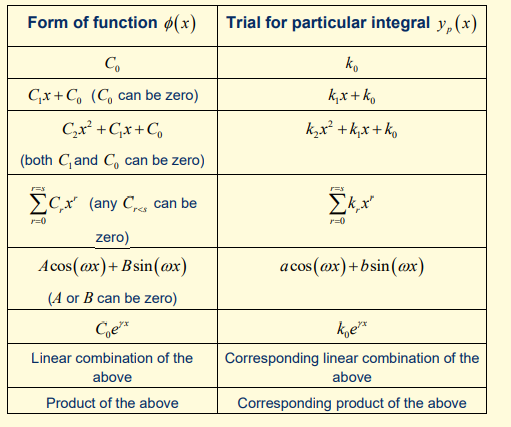5- Linear inhomogeneous differential equations
1/9
There's no tags or description
Looks like no tags are added yet.
Name | Mastery | Learn | Test | Matching | Spaced |
|---|
No study sessions yet.
10 Terms
What is the general form of a second-order linear inhomogeneous ODE with constant coefficients?


What are the two components of the general solution to a second-order inhomogeneous ODE?
Complementary function yc(x): Satisfies the homogeneous equation L2[yc(x)] =0
Particular integral yp(x): A specific solution that satisfies L2[yp(x)]=ϕ(x)

How is the general solution to the inhomogeneous ODE formed?
The general solution is the sum of the complementary function and the particular integral:

How is the complementary function yc(x) determined?

What is the purpose of the particular integral yp(x)?
Its a specific solution that accounts for the inhomogeneous term ϕ(x)
It ensures that the full equation L(y)=ϕ(x) is satisfied.

What is the method used to find the particular integral?
The method of undetermined coefficients
This nvolves guessing a trial solution with unknown constants and determining their values by substitution.
What is the basic idea behind the method of undetermined coefficients?
Assume a trial solution yp(x) with unknown constants.
Substitute yp(x) into the differential equation.
Solve for the unknown coefficients to satisfy the equation.
What is the key requirement for using the method of undetermined coefficients?
This method only works if ϕ(x) is a polynomial, exponential, sine, or cosine function (or a combination of these).
Table used for the method of undertermined coefficients

What should you do if a term in the trial solution yp(x) is already present in the complementary function yc(x)?
Multiply the trial solution by xm, where m is the lowest power that ensures no term in yp(x) duplicates yc(x).